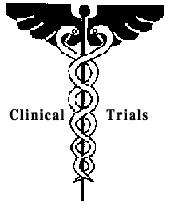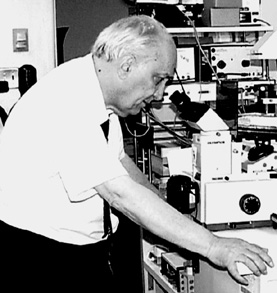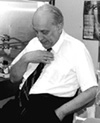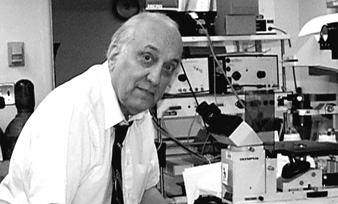
| T H E N I H C A T A L Y S T | M A R C H - A P R I L 1 9 9 8 |
| ANTI-TAC TAKES OFF IN THREE DIRECTIONS | by Fran Pollner |

|
The drug sponsor, Hoffmann-LaRoche, named the agent Zenapax®. But to the people at NIH who have traveled the complete bench-to-bedside route with the antibody, it's always been known as "anti-Tac," short for its essential function--anti-T-cell-activation.
The anti-Tac work has been led by principal investigator Tom Waldmann, chief of the NCI metabolism branch, who moved anti-Tac from its production in the laboratory through to animal and clinical studies, modifying it along the way to make it more friendly to the human immune system and more deadly to its target. The anti-Tac antibody is a monoclonal antibody directed against the alpha subunit of the interleukin-2 receptor (IL-2R alpha).
"For the last 14 years, there has been an array of protocols directed toward the IL-2 receptor," Waldman recounted in an interview. "The scientific basis for these trials is that IL-2R (Tac) is expressed by a whole series of leukemia and lymphoma cells--but not normal resting cells it's expressed also on the surface of T-cells involved in a retroviral-associated neurological disorder and a host of autoimmune diseases, such as uveitis, arthritis, systemic lupus erythematosus, inflammatory bowel disease, and the like," as well as the rejection of organ grafts.
In sum, any condition marked by deranged T-cell activation--significantly, autoimmune diseases and certain cancers--may be a candidate for anti-Tac maneuvers, Waldmann said.
A series of NIH clinical protocols dating to 1983 has brought the anti-Tac approach to the threshold of recognition as a treatment in these other conditions, as well as in organ transplantation. The cDNAs encoding IL-2R alpha were cloned and sequenced in Waldmann's lab, where, in 1981, Waldmann and Takashi Uchiyama created the anti-Tac antibody. There are about a dozen clinical protocols now going on, most with fewer than 20 patients and none targeted to recruit more than 45. Waldmann envisions more trials in the not-too-distant future.
One of Waldmann's central projects is the development of anti-Tac as a vehicle for directed internal irradiation of T-cell malignancies. It is that use, he says, that is serving as a prototype for a strategy in cancer therapeutics that he calls systemic radioimmunotherapy. He sees the application of this basic strategy not only in leukemias and lymphomas but also in the more common and more difficult-to-reach solid tumors, like breast, ovarian, and gastric cancer, if appropriate tumor-specific receptors, comparable to Tac, can be found.
From Bench to Bedside in ATL
From the outset it was clear that anti-Tac had exciting potential for improving treatment of one of the most intractable types of leukemia. Waldman recalls, "Using hybridoma technology, we first produced our antibody--a mouse monoclonal antibody--to Tac in 1981 and relatively quickly showed that virtually all the leukemic cells and none of the normal cells in patients with adult T-cell leukemia (ATL) expressed the Tac antigen." The next step was defining the antigen as one of three chains in IL-2R, which itself was undefined at the time. Waldmann's lab is currently conducting therapeutic trials of antibodies to the ß chain as well as the alpha chain.
Initial clinical trials focused on diseases caused by human T-cell lymphotropic virus-1 (HTLV-1), predominantly ATL, an extremely aggressive leukemia. Regardless of which chemotherapy ATL patients receive, their median survival duration is just nine months post diagnosis. ATL was clearly a malignancy in need of a new therapeutic approach.
|
--Tom Waldmann |
Waldmann's laboratory studies indicated that anti-Tac might be just the ticket. He had demonstrated differences in receptor expression between normal and malignant cells in ATL patients, with the normal cells nonreactive to anti-Tac. By contrast, the malignant cells each displayed 10,000 to 35,000 reactive IL-2R alpha chains of the receptor on their surfaces. The leukemia cells were also locked into an autocrine feedback loop in their early stages of malignant proliferation as the virally induced IL-2 production drove heightened IL-2 alpha expression.
Using the murine anti-Tac monoclonal, Waldmann and his team set out to saturate the receptors and block IL-2 binding, essentially starving the leukemic cells of the cytokine that was central to their proliferation. Thus far, in their first ATL protocol, 19 patients have been treated. Six patients have had remissions--two of them complete. "I saw one of these two yesterday, as a matter of fact," Waldmann noted during an interview in February. "Eight years out, and he is still in complete remission," he said, smiling.
"In a true complete remission, you are eliminating all malignant cells. We have no evidence--on any level--of residual tumor in this 72-year-old patient, whom we evaluate every year," he elaborated. "There is no evidence of monoclonal rearrangement in T-cells the level of soluble IL-2 receptor, a surrogate marker of leukemia, is even lower than normal there are no malignant cells in the peripheral blood his serum calcium levels are fine there's no evidence of the retrovirus. He's lived well enough to have had a successful hip replacement procedure."
Waldmann says the stage of a patient's disease when he or she enters the trial is a factor in the success or failure of the approach. Patients with chronic ATL, a subset with a more favorable median survival duration of 24.1 months, tended to respond better to anti-Tac. In these patients, ATL is still in a self-stimulatory mode--with leukemic cells produced by the IL-2/IL-2R alpha autocrine interaction. Oddly enough, the eight-year survivor did not fit this pattern. "Overall, our success in chronic ATL is seven of nine patients in acute ATL, it's nine of 26 and in acute ATL with a history of repetitive chemotherapy failures, it's zero of nine," Waldmann said.
But, he quickly added, these first studies used unmodified murine anti-Tac. "There are major limitations to this treatment: The mouse monoclonal survives only 40 hours in humans it's recognized as foreign by the human immune system, which means repeat courses often must be abandoned and, finally, it is not a very effective killing agent. It can prevent the cell from seeing its growth factor, but it cannot carry out antibody dependent cellular cytotoxicity (ADCC) against human cells."

Tom Waldmann
"We continue in an iterative or developmental way to recognize limitations, modify our protocol accordingly, and move to hopefully better therapeutic approaches to the IL-2 receptor." |
Those limitations pointed the way to improvements and subsequent trials. "We continue in an iterative or developmental way to recognize limitations, modify our protocol accordingly, and move to hopefully better therapeutic approaches to the IL-2 receptor," Waldmann said. The original ATL protocol remains open to patients who would be ineligible for a new Phase I trial of a later-generation anti-Tac.
Anti-Tac with a Human Face Overcomes Transplant Rejection
One of the first modifications was to humanize the anti-Tac antibody, a project undertaken with Cary Queen, then of the NCI biochemistry branch and soon after of Protein Design Labs, a company he established. The antigen-combining region from the mouse was retained and the remaining 90 percent of the antibody was converted to a human IgG1. The modified antibody still bound tightly to the Tac leukemic cells it had drastically reduced immunogenicity its half-life in the human body was now a whopping 20 days and to top it off, it had ADCC function against human cells.
Clinical trials with humanized anti-Tac initially focused on graft rejection and autoimmune conditions rather than cancer, and it was this fact that led to graft rejection's becoming the first approved application for anti-Tac, rather than leukemia, in which it first showed promise. With NHLBI collaborators, Waldmann's group had demonstrated the utility of murine anti-Tac in preventing cardiac graft rejection in cynomolgus monkeys. Collaborators at Harvard Medical School in Boston, led by Robert Kirkman, then evaluated anti-Tac in a Phase I/II clinical trial in kidney transplant patients. The results of these trials encouraged Hoffmann-LaRoche to step in and sponsor multicenter Phase III randomized, placebo-controlled clinical trials involving 535 kidney transplant patients.
"Phase III trials are almost always best done by industry," Waldmann observed, "and in this case, it was imperative, since NIH does not do organ transplants at the Clinical Center." In two sets of clinical trials--one in Europe involving two standard immunosuppressive agents plus humanized anti-Tac or placebo and the other in the United States that followed the same protocol but involved three standard immunosuppressants plus or minus anti-Tac--anti-Tac achieved a 40 percent reduction in organ rejection episodes prolonged graft and patient survival were also documented. Moreover, Waldmann noted, typical immunosuppressant-associated toxicity was not associated with anti-Tac administration. "It appears that by reducing the rejection episodes and the need for salvage with high-dose corticosteroids or OKT3, both of which are associated with increased infection," anti-Tac overcame that particular drawback, he said. The results were impressive enough to win anti-Tac (Zenapax®) FDA approval for marketing to prevent kidney transplant rejection.
   
|
|
"Eight years out, and he is still in complete remission,"
Waldmann exulted at the status of a 72-year-old ATL patient,
who has received no treatment beyond his original NIH protocol.
"In a true complete remission, you are eliminating all malignant cells.
We have no evidence--on any level--of residual tumor (in him)," the researcher said.
|
The company stated its intention to test the product in other organ transplantation procedures, an undertaking Waldmann projects will prove successful for any vascularized solid organ transplants. Only in bone-marrow transplants, where the graft-vs.-host disease does not involve IL-2, would anti-Tac not be effective, he said.
An Autoimmune Tack
Other anti-Tac studies at the Clinical Center have targeted autoimmune diseases: uveitis, a T-cellmediated blinding disease of the eye, and tropical spastic paraparesis (TSP), an HTLV-1induced demyelinating neurological disease with effects akin to multiple sclerosis. Both are being conducted in collaboration with other institutes. NEI's scientific director, Robert Nussenblatt, serves as principal investigator in the uveitis studies. The TSP work is a joint endeavor with NINDS co-PIs Henry McFarland and Steve Jacobson.
Blocking the self-stimulatory cycle of IL-2 and its receptor is proving its value in both conditions. Most uveitis patients treated with humanized anti-Tac either retained their visual acuity or improved, even though they were withdrawn from the potent immunosuppressive agents (steroids and cyclosporine) that they had previously depended upon for their sight.
Among TSP patients treated with humanized anti-Tac, viral load diminished by 30 to 70 percent, and abnormal T-cell proliferation abated. Progression of neurologic disease was halted in all patients, and many actually showed improvement.
Waldmann and his colleagues believe that another cytokine is involved along with IL-2 in TSP. In the chain of events initiated by HTLV-1 infection--T-cell activation through a transactivating protein called tax, triggering T-cell division and autocrine production of IL-2 and IL-2 receptors--it appears that "these cells are also making a cytokine we codiscovered during our adult T-cell leukemia trials--IL-15," Waldmann said. He believes that an antibody to the ß chain of the IL-2 receptor, which is shared by IL-2 and IL-15, would stop the IL-15driven division and, in select circumstances, also block IL-2 effects.
In fact, Waldmann serves as study chairman of a protocol headed by NCI's Jeffrey White, who is testing an antibody to the ß subunit of IL-2R in patients with T-cell large granular lymphocytic leukemia. The antibody--Mik-ß-1 is directed against IL-2R, which is expressed by the leukemic T-cells but not by normal resting cells. Mik-ß-1 appears to block the actions of both IL-2 and IL-15 on the receptor ß chain. In Phase I clinical safety trials, Mik-ß-1 has been tested in six leukemia patients in late stages of disease--stages that are probably "beyond the time when IL-2 and IL-15 are the driving forces," Waldmann noted, which would explain the absence thus far of hints of clinical improvement. Nevertheless, the study is "showing that this is a safe approach to blocking IL-15 function--and one that might more easily be effective in autoimmune conditions."
|
--Tom Waldmann |
Waldmann sees multiple sclerosis, psoriasis, sarcoid, and systemic lupus erythematosus among autoimmune diseases that would be candidates for IL-2R therapy with humanized anti-Tac. Mik-ß-1 therapy, however, may be more suitable in rheumatoid arthritis and inflammatory bowel disease, in which IL-15 seems to have the dominant role, he said. He will test this strategy as soon as the humanized form of Mik-ß-1 becomes available, probably later this year.
Anti-Tac Armed Against Malignancy
In the clinical testing of anti-Tac against malignancy, the antibody has not only been humanized but also souped up to deliver a killing agent to the surface of the tumor cell. "When one turns to malignancy," Waldmann explained, "one wishes to arm the antibody with a toxin* or a radionuclide. My focus is on systemic radioimmuno-therapy, which replaces the large external radiation-delivering machine with a radionuclide with a relatively short distance of action and the ability to kill the cells in its environment."

"The challenge is on those of us in the field
to develop radiolabeled antibodies to common tumors...
I think an anti-Her2-neu antibody labeled with astatine
could be tested three years from now (in a solid tumor adjuvant setting)..."
|
Beginning in 1990, first with murine and then with the humanized version, anti-Tac has been coupled with a ß-emitting radionuclide, yttrium-90 (90Y) in protocols involving patients with ATL and other Tac-expressing leukemias and lymphomas. NCI radiation oncologists Otto Gansow and Martin Brechbiel made this attacker-antibody, Waldmann noted.
Radiolabeling murine anti-Tac improved its clinical powers, bringing remissions in nine of 16 patients enrolled in its trial. Two of the remissions were complete and long lasting, and the partial remissions were sustained for longer periods than had been achieved in earlier trials with simple murine anti-Tac. As with those earlier trials, repeat courses were often precluded by the mobilization of the patients' immune defenses against the mouse antibody.
The most active protocols today are those testing 90Y-radiolabeled humanized anti-Tac, not only in ATL but in other leukemias and lymphomas that display IL-2R alpha. The most recent ATL trial, started by Waldmann in late 1996, includes the addition of a chelating agent--calcium-DTPA--to accelerate urinary excretion of 90Y, thereby increasing the maximum tolerated dose 1.5- to twofold. "Not enormous," Waldmann commented, "but in a range where increase may alter efficacy." A companion protocol, begun last year and headed by Jeffrey White, includes patients with other hematologic malignancies that express Tac, such as non-Hodgkin's lymphoma, Hodgkin's, cutaneous T-cell lymphoma, and peripheral T-cell lymphoma.
Future Paths
"Not too far down the road," Waldmann said, "we will move from the beta-emitting radionuclides, like 90Y, to the alpha-emitting radionuclides, which have a much shorter distance of action. Beta-emitters have approximately a half-centimeter of effective action, which means they can be toxic to bone marrow. Alpha-emitters have only one or two cell diameters of action--and are very effective in killing the cell on which they sit." Among the alpha-emitting radionuclides that are being studied in his lab, astatine 211 (AT-211) is a prime candidate for future studies, he said. Agents linking it to anti-Tac antibody are under investigation, and he anticipates using the alpha-emitting astatine-labeled anti-Tac monoclonal antibody in the treatment of leukemia and lymphoma within a year or two.
Moreover, following the same strategy, he continued, astatine radionuclide could be coupled to a monoclonal antibody directed against antigens other than Tac, such as those expressed in solid tumors. "We have done in vitro studies with Her2-neu as the target. Her2-neu is overexpressed by the tumors of 30 percent of patients with breast, ovarian, and gastric cancers, including many with the worst prognosis," Waldmann said. "So the Her2-neu receptor would be our target for these malignancies. Each malignancy would define its own receptor." He noted that microarray techniques comparing tumor tissue with normal tissue will aid in defining surface receptors as targets for therapy. "The basic approach," he said, "requires that the tumor cell display a receptor that is not expressed by a cell you must retain for good life."
He sees its use first in the adjuvant setting, to eliminate residual tumor cells after primary radiation or surgical therapy. "I think an anti-Her2-neu antibody labeled with astatine could be tested three years from now," provided current studies yield means to ensure its rapid relay to the tumor cells, he said. Trials with bulky tumors and metastatic disease are still some time away.
Closer at hand, Waldmann expects, are modest Phase III trials to establish systemic radioimmunotherapy as a valuable approach to cancer therapy. Acceptance of systemic radioimmuno-therapy is stalled by the lack of such trials, he said. He proposes that the Clinical Center serve as a site for the controlled comparison of anti-Tac alone vs. 90Y-radiolabeled anti-Tac. "Basically, I would share the view that the Clinical Center is not the place for a Phase III trial, but we feel that with a total accrual of only 25 patients in each arm," efficacy might be demonstrated and a "precedent would be set," he said. This, in turn, could open the doors to large studies conducted by regional cancer trials groups to see whether systemic radioimmunotherapy might become a standard weapon against cancer.
"The challenge is on those of us in the field to develop radiolabeled antibodies to common tumors," Waldmann said. "For slow-growing, solid tumors, one wants new approaches. Whether they be cancer vaccines or gene therapy, we need to give other approaches a chance, and I sense that systemic radioimmunotherapy is one of them."
*Another protocol based on the same strategy hitches a toxin fusion protein, instead of a radionuclide, to anti-Tac antibody. Opened in 1996, this study represents a collaboration with Robert Kreitman, who is the PI, and Ira Pastan, of NCI's Laboratory of Molecular Biology, and uses Pseudomanas exotoxin. (see The NIH Catalyst, July-August 1997 issue, page 4 in hard copy).